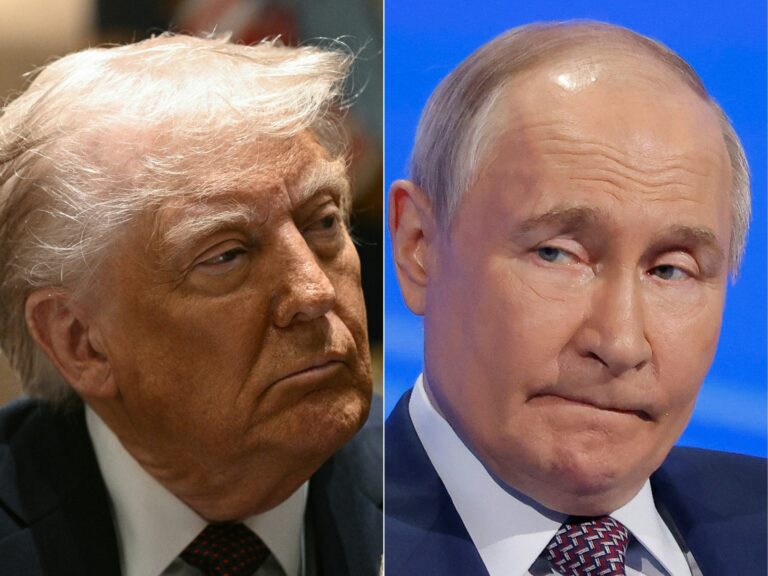President Donald Trump said on Sunday that he was “P**** off” with Russian counterpart Vladimir Putin and would slap additional financial penalties for Russian oil sales if he disagrees with a ceasefire in Ukraine.
The comments showed a sudden shift in tone from Trump, which has been open to peace talks with Moscow since the start of his second term in January.
There are details about what happened, the Trump threat could be involved, and why this is important for the Putin war with Ukraine and the country that buys Russian oil.
What did Trump say about Putin?
In an interview with NBC on Sunday, Trump said he was “very angry” and “p****off” against Putin, who questioned the legitimacy of Ukraine’s Voldymir Zelensky.
Trump argued that the move to replace Zelensky as Ukrainian leader would inevitably slow the prospect of a ceasefire.
But Trump added that Putin knew he was angry with him. He said that he and Putin had a “very good relationship” and that “the anger dissipates quickly… if he does the right thing.”
What did Putin say about Zelenskyy?
Putin said Zelensky lacked the legitimacy to sign a peace agreement.
Russian leaders have frequently argued that the Ukrainian government is illegal since the overthrow of President Viktor Yanukovich, who is leaning towards Moscow, who the Kremlin claimed was supporting us in 2014.
On Thursday, President Putin proposed that a temporary government be established in Ukraine under UN oversight. The proposal was rejected by UN Secretary-General Antonio Guterres.
Zelenskyy was sworn in 2019 as president of Ukraine for a five-year term. The war broke out in February 2022 following a full-scale invasion of Russia’s Ukraine. Ukraine was supposed to hold a presidential election in 2024, but the country is taking place under martial law for war, and the constitution does not allow elections to be held under martial law.
Trump is now criticizing Putin for questioning Zelensky’s legitimacy as Ukrainian president, but American leaders did the same a while ago.
In February, amid tensions with Ukrainian leaders, Trump described Zelensky as a “no-election dictator” in a post on a true social platform.
What is the state of diplomatic efforts to end the Ukrainian war?
During the presidential campaign, Trump promised to quickly suspend the Ukrainian war.
Since his appointment, the US negotiation team has met with Russian and Ukrainian teams multiple times in Saudi Arabia to discuss terms of peace. Trump has since spoken separately to Putin and Zelensky.
The three sides agreed to halt the use of military force in the Black Sea on March 25th. They also agreed to suspend attacks on Russia and Ukraine’s energy infrastructure for 30 days. However, both sides accused each other of violating this and attacking energy facilities.
Ukraine and the United States had agreed to a 30-day land and sea complete ceasefire, with Russia’s approval being held back. Putin has not signed the proposal. Ukraine uses the period to ramble through itself, including the supply of state-of-the-art Western weapons, citing mobilization of more soldiers when faced with a talent shortage.
What did Trump threaten – does it work?
Trump threatened “secondary tariffs” on Russian oil if he deemed Moscow liable to be held responsible for not reaching a ceasefire agreement.
“If Russia and I can’t get a contract to stop the bloodshed in Ukraine and if it’s Russia’s fault, that may not be the case, but if it’s Russia’s fault, I’m going to put secondary tariffs on all the oil coming out of Russia,” Trump said.
“That means that if you buy oil from Russia, you can’t operate in the US. There is a 25% tariff on all oil, and there is a 25-50 point tariff on all oil.”
Kiel Giles, a senior consulting fellow at the London-based Chatham House think tank, told Al Jazeera it is unclear whether these threats will put pressure on Russia.
“We’ve seen sporadic threats from Trump that put some kind of economic pressure on Russia, but they’re not going to last,” Giles said.
“I don’t know if this threat is open or not, but the previous threat was. Putin knows that,” Giles said.
What is secondary customs?
“Second-order tariffs” appear to mean tariffs on imports from countries that purchase Russian oil.
The US has long been running an LED campaign for what is known as secondary sanctions, where countries that trade with sanctions also face sanctions. Secondary sanctions have been implemented for example on the purchase of Iranian oil or heavy military equipment from Russia. Countries, businesses and individuals engaged in this trade are at risk of US sanctions.
The threat of secondary US sanctions is also the reason why most global banks and financial institutions no longer participate in trade with Russia and Iran.
In contrast, secondary tariffs have been relatively untested as a phenomenon. Last week, Trump also imposed a 25% secondary tariff on US imports from countries that buy oil and gas from Venezuela.
Which countries could Trump’s secondary tariffs hurt?
India and China could be particularly hit hard if Trump imposes secondary tariffs on Russian oil.
India and China are two biggest buyers of cheap Russian crude oil.
Russian oil accounted for 35% of India’s crude imports in 2024, but accounted for 19% of China’s oil imports. Torkier is also a Russian oil importer. In 2023, 58% of sophisticated oil imports came from Russia.
How much does secondary tariffs cause China, India and Torkie?
If Trump imposes these tariffs, it is unclear whether they will be added to existing tariffs or absorb other tariffs that are already in effect.
The US is China’s only and largest export market. In 2024, China sold $463 billion worth of goods to the United States. But Trump has already imposed a 20% tariff on all imports from China.
India also counts the US as its largest export market. Exports to the US to India were $91 billion in 2024. However, Trump has repeatedly won against India’s high tariffs on US imports.
Turkiye is relatively unexposed. The US is the second largest export market after Germany, with $17 billion in 2024.
However, since April 2nd, Trump has been threatening mutual, strict tariffs on all US trading partners.
And if Trump really cracks down on the country buying Russian oil, India in particular can find itself under Washington’s scrutiny. That’s because India, the world’s largest oil refinery in Jamunagar, a western province of Gujarat, has been accused of purchasing subsidised Russian oil, refined it and selling it to the West, and is accused of effectively helping Moscow weaken Western sanctions.
In 2023, India exported sophisticated petroleum products such as petrol and diesel to countries including the United States, the UK, France and Belgium, which suffer from strict sanctions over Russian crude imports, according to data from the Observatory of Economic Complexity (OEC).
After Canada, India is the second-largest exporter of refined oil to the United States, accounting for 7.5% of US oil exports as of 2023, OEC data shows.
But India has long argued that by purchasing Russian oil, India will free the crude from other sources such as the Middle East and Africa, and that Western countries will buy it and continue to control global oil prices. If oil from Russia, the main producer, is no longer available to anyone, all countries will have to scramble for crude supply from elsewhere, raising prices.




